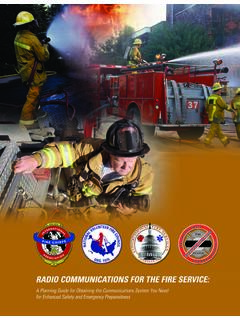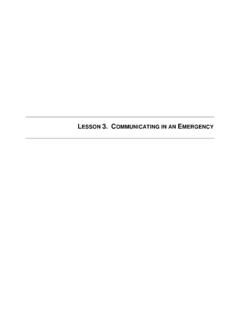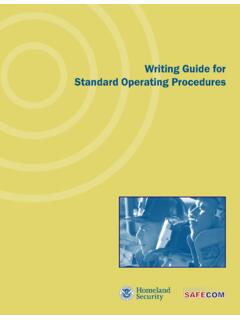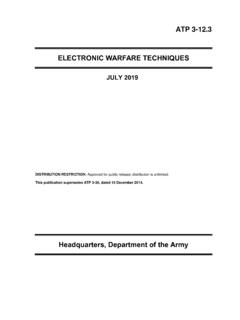Transcription of Communications in the Incident Command System
1 Number 2 May 2007. Communications in the Incident Command System By Dan Hawkins SEARCH. introduction military roots to serve domestic emergen- Unfortunately, as we have often seen, cy response needs, including communica- Communications and Command failures Communications is an inseparable tions. Today, ICS provides a rich set of are intertwined. Structured, consistent component of modern Command and tools for managing human and techno- means of managing Communications control systems. In the United States, logical resources to ensure effective and resources are necessary, particularly dur- the Incident Command System (ICS) has efficient management of emergencies of ing incidents involving multiple agencies.
2 Evolved during the past 30 years from its all scales. ICS establishes basic principles, practical tools, and a definitive structure for sup- porting Communications needs during Acronyms emergency response. Unit Leader Communications Technician This Issue Brief presents background on of Homeland Security Communications within the National Incident Management System and its Security Presidential Directive Incident Command System . It examines Commander the role of Communications within these Communications Center constructs, as well as in the context of Command Post multiagency response to disasters and Command System emergencies.
3 It concludes with opera- Communications Center Manager tional best practices for effective use of Interagency Incident Management System Incident Communications units. Incident Management System Preparedness Goal Homeland Security Response Plan Presidential Directives Operator In 2003, President George W. Bush issued Operating Procedure two directives that have had a profound Capabilities List impact on emergency response and man- Interoperable Communications Plan agement in the United States. Homeland Area Security Initiative Security Presidential Directive 5 (HSPD- 5), issued on February 28, and HSPD-8, Task List issued on December 17, are only in the beginning phases of implementation by HSPD-8 and local emergency operations plans are local, state, tribal, and federal govern- HSPD-8, National Preparedness, intended to be aligned.
4 Emergency opera- ments. provided further definition of require- tions plans are supported by or built on ments that would affect agencies receiv- standard operating procedures (SOP). HSPD-5 ing federal Its purpose is to that are intended to be consistent with HSPD-5, Management of Domestic strengthen preparedness capabilities NIMS guidelines, standards, and proto- Incidents, established a single, compre- of all levels of government to terror- cols. Emergency planners are expected hensive National Incident Manage- ist attacks, major disasters, and other ment System (NIMS), to be developed emergencies.
5 It required development of and administered by the Department of a National Preparedness Goal (NPG)5. Homeland Security (DHS) for use by all that includes readiness metrics, as well as levels of It noted that for full implementation of a closely coor- purposes of interoperability and compat- dinated interagency grant process for to identify tasks from the UTL that their ibility, first responder preparedness assistance organizations need to perform based on by the end of federal Fiscal Year 2005. their assigned roles and mission. The TCL. NIMS [would] include a core set of The directive notes that, [t]o the extent descriptions are used to determine the concepts, principles, terminology, and permitted by law, Federal preparedness capabilities needed to accomplish these technologies covering the Incident assistance will be predicated on adoption tasks.
6 Command System ; multi-agency coor- dination systems; unified Command ; of Statewide comprehensive all-hazards preparedness strategies. Currently, there are 36 capabilities in training; identification and manage- the TCL, of which 32 are grouped into ment of resources (including systems Three of the seven national priorities four mission areas: prevent, protect, for classifying types of resources);. articulated in the NPG are particularly respond, and recover. The remain- qualifications and certification; and relevant to the Communications aspect of ing four are capabilities common to all the collection, tracking, and reporting emergency response: mission areas.
7 Interoperable communica- of Incident information and Incident tions is second among the four common resources. 2 Implementation of a NIMS. HSPD-5 also required the Secretary of Strengthening of information-sharing DHS to develop, submit for approval, and collaboration capabilities and administer a National Response Strengthening Communications Plan (NRP) that would use NIMS for the interoperability. provision of federal support to state and local agencies during domestic incidents. The NPG relies on an approach called Adoption and incorporation It required the adoption and use of NIMS Capabilities-Based Planning to reach of NIMS and the capabilities listed on by federal agencies in support of state the goal.
8 The approach uses 15 standard- the TCL will lead to advanced interagency and local government during domestic ized National Planning Scenarios, a Communications that support common incidents and established federal Fiscal Universal Task List (UTL) to reference response processes. Year 20053 as the beginning of require- tasks performed by all levels of govern- ments for NIMS adoption by state and ment and different disciplines during Specific information on the National local agencies receiving federal prepared- incidents, and a Target Capabilities List Response Plan tasks and capabilities can ness assistance.
9 It also required develop- (TCL) that identifies capabilities needed be found in the DHS Lessons Learned ment of standards and guidelines for to perform the tasks. Information Sharing web assessing that adoption. The National Response Plan provides a concept of operations with which state 6 The other three are planning, citizen prepared- ness and participation, and risk management. 1 See releases/2003/02 4 See 7 The Lessons Learned Information Sharing web releases/2003/12 site is available only to emergency response 2 Ibid. providers and homeland security officials. Reg- 5 See istration is required and eligibility is verified.
10 See 3 October 1, 2004 September 30, 2005. Communications in the Incident Command System Effects of HSPD-5 and -8. on Local Agencies The federal government has been most significantly affected by these presidential directives. Local government, however, is recognized as the provider of the vast majority of first response capabilities in the United States. As reliance on federal funding of local first response has grown since the events of September 11, 2001, local agencies have become subject to the presidential directives. One intent and effect of the HSPDs was to standardize the mechanisms by which government agencies work together during emergency incidents.















